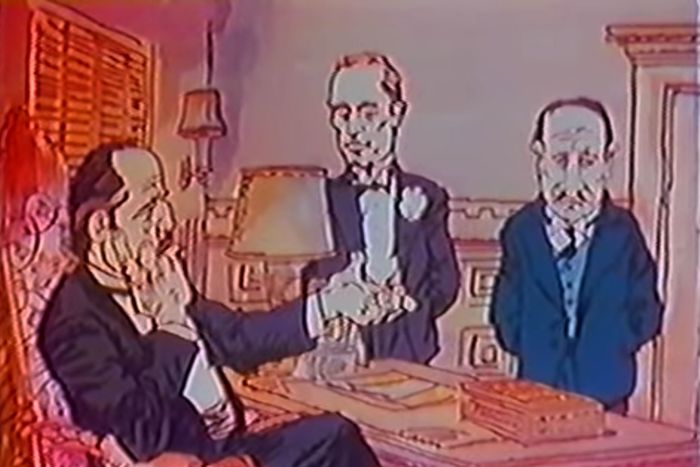
It was announced last week that after 67 years, the days of MAD magazine publishing new material each month will soon be no more. The tributes poured in immediately as fans, such as Weird Al, voiced their sadness. Even if you never read the magazine, you’ve no doubt felt its effects in some way, either through the numerous comedians and writers it has inspired over the years or through the two television series (MADtv and Cartoon Network’s Mad) that have carried the name. But you may not have known that the attempts to bring MAD to television started as far back as 1973 when ABC commissioned an animated pilot, later rebranded as a television special, that never made it to air: The Mad Magazine TV Special.
In the 1970s, MAD magazine was at the height of its popularity, having established its reputation for taking no prisoners (or advertisers) and refusing to talk down to the teens who made up the bulk of its audience. In 1974, it hit its peak circulation at 2.1 million, and with the more adult National Lampoon nipping at its heels, the time was right for the MAD brand to expand into other mediums. The special was announced as a direct translation of the magazine to television, bringing along the original artists to be “enhanced by the dimensions of motion and sound.” Whether or not the art of Mort Drucker, Don Martin, and Jack Davis needed to be enhanced by these dimensions was not debated.
The first sketch of the program looks as though it was ripped directly from the pages of the magazine for a few different reasons. First, it looks exactly as if Jack Davis’s art style was transplanted to the screen. Second, it’s clear that the animation budget didn’t allow for a whole lot more than that. At times, it feels as though the material was originally designed as a radio show with a few drawings added to supplement the original magazine material.
In it, a Lee Iacocca–type gives a Walter Cronkite–type a tour of an automobile plant where cars fall apart at every turn, where safety belts are tested not for passenger safety but to keep the car together, and where Henry Ford is discussed as a “commie radical.” As satire goes, it feels rather gentle by today’s standards, but was no doubt far harsher than any major company was used to in 1974.
Mort Drucker’s distinctive art style is immediately evident in the show’s centerpiece sketch, a parody of The Godfather called “The Oddfather.” Easily the longest sketch of the show, taking up a full third of the half-hour, “The Oddfather” goes through the entire plot of the film that inspired it, poking fun at every major story beat. If you’ve ever read one of these classic MAD parodies, then you already know just how many jokes they’re able to cram into one page. Just take a look at how much text and how many goofy character names are shoehorned into this double-page spread from the original “Oddfather” piece from the magazine.
The “Oddfather” sketch is incredibly faithful to the source material, keeping in almost every joke from the original comic, both written and visual. One of the only exceptions to this rule is that rather than changing Brando’s name to “Brandow” — which would be undetectable when said out loud — the pilot refers to the actor as “Marlo Brandin,” transposing a few letters to avoid litigation. The sketch has a few great jokes, including a runner about what it means to die of natural causes in New York City, but goes on more than a few minutes too long. When the art in the magazine is as detailed as Drucker’s you can savor it and spend time with each joke, but when it remains relatively stationary on a television screen, it suddenly becomes a lot less compelling.
The parts of MAD magazine that seems to translate best to animation are some of the quick throwaway gags, such as the Don Martin blackout sketches, or Antonio Prohias’s classic “Spy vs. Spy” segment that would also be adapted in each of the MAD magazine television incarnations. In these segments, where the original art style is far more cartoonlike, the translation to movement comes a lot easier and begins to feel more like a TV show, rather than a read-along record accompanying a magazine.
The Mad Magazine TV Special was ultimately just fine, but it doesn’t seem to be issues of quality that kept it off the air. In the opening titles, the announcer gives a preview of the segments that will appear within the special, then tells the audience that the show was brought to them by … and then there is a lot of dead air for a sponsor’s name that was never filled. According to Cartoon Brew, MAD writer Dick DeBartolo wrote to TV Funhouse animator J.J. Sedelmaier about the special, saying, “Nobody wanted to sponsor a show that made fun of products that were advertised on TV, like car manufacturers.” And even if you weren’t the Ford Motor Company with your company president being parodied, who’s to say your company wasn’t going to be the subject of the next Mad Magazine Special? And so, MAD’s first attempt at television would remain an unaired pilot, hidden away in the MAD offices until one day, decades later, when the internet existed.




